-
The ceremony
-
The ceremony will be held over five days from Oct 25 to Oct 29, with the cremation taking place on the second day.
Thousands of soldiers, chanting monks, conch-shell blowers, drummers and musicians will be taking part in the ceremony. The guests will include dignitaries from foreign countries. Most Thais will watch the ceremony live on TV.
After the ceremony, about 100 soldiers will carry the King's ashes on a two-century-old wooden chariot that weighs more than 2,000kg. The urn, however, is only symbolic as the real one will be transported privately.
The ashes will be kept in two temples near the Grand Palace: Wat Ratchabophit, where ashes of two previous kings are also kept, and Wat Bowonniwet Vihara, where King Bhumibol Adulyadej spent 15 days as a monk in 1956. The remaining bones will be enshrined as royal relics at the Throne Hall in the Grand Palace. The royal funeral complex will be open to the public for a month afterwards before being dismantled.
WORLD FOCUS
Labour of love for Thais' most beloved king
Thais hard at work preparing funeral pyre for the last rites of King Bhumibol Adulyadej, to be held on Oct 26
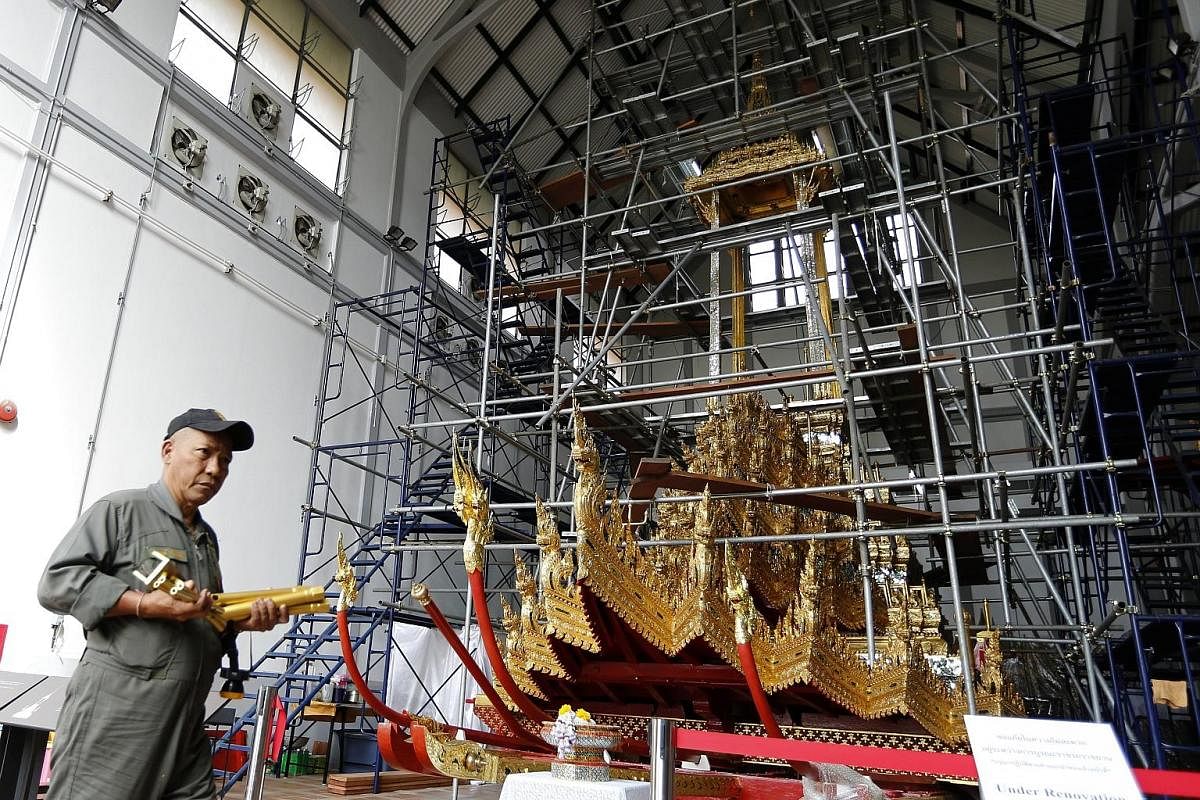
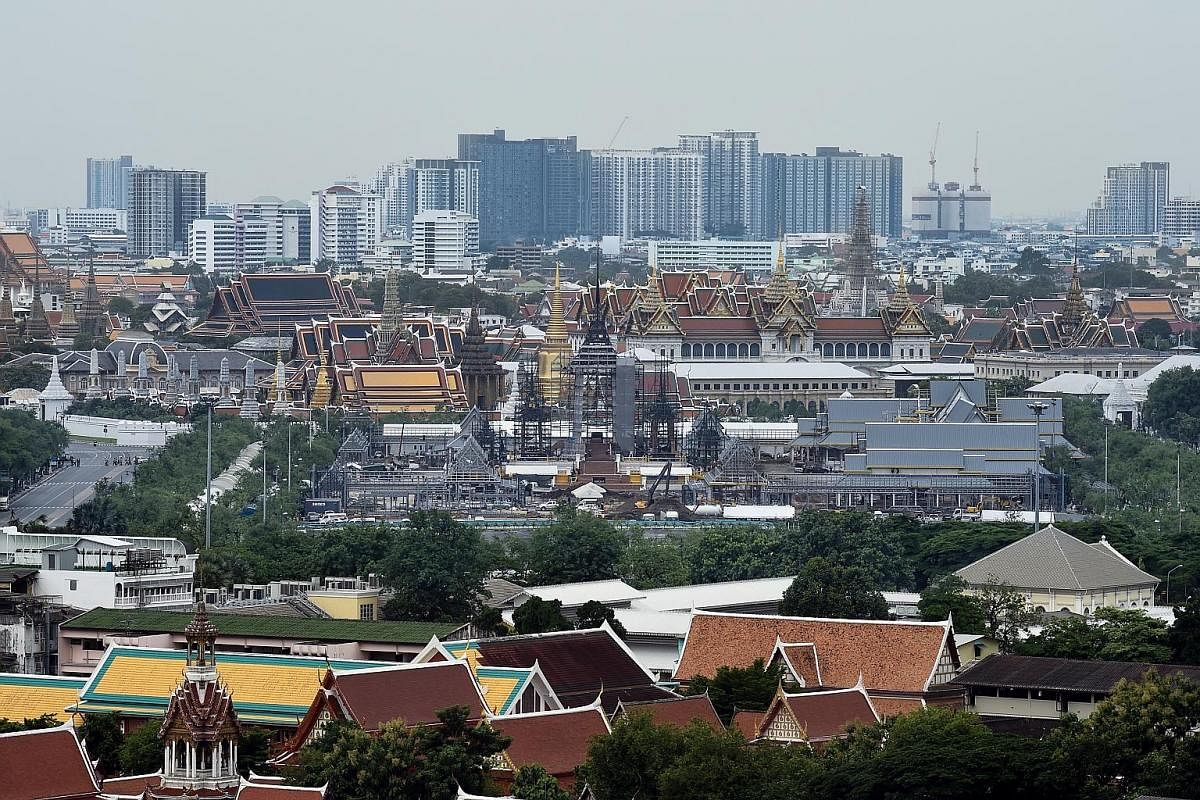
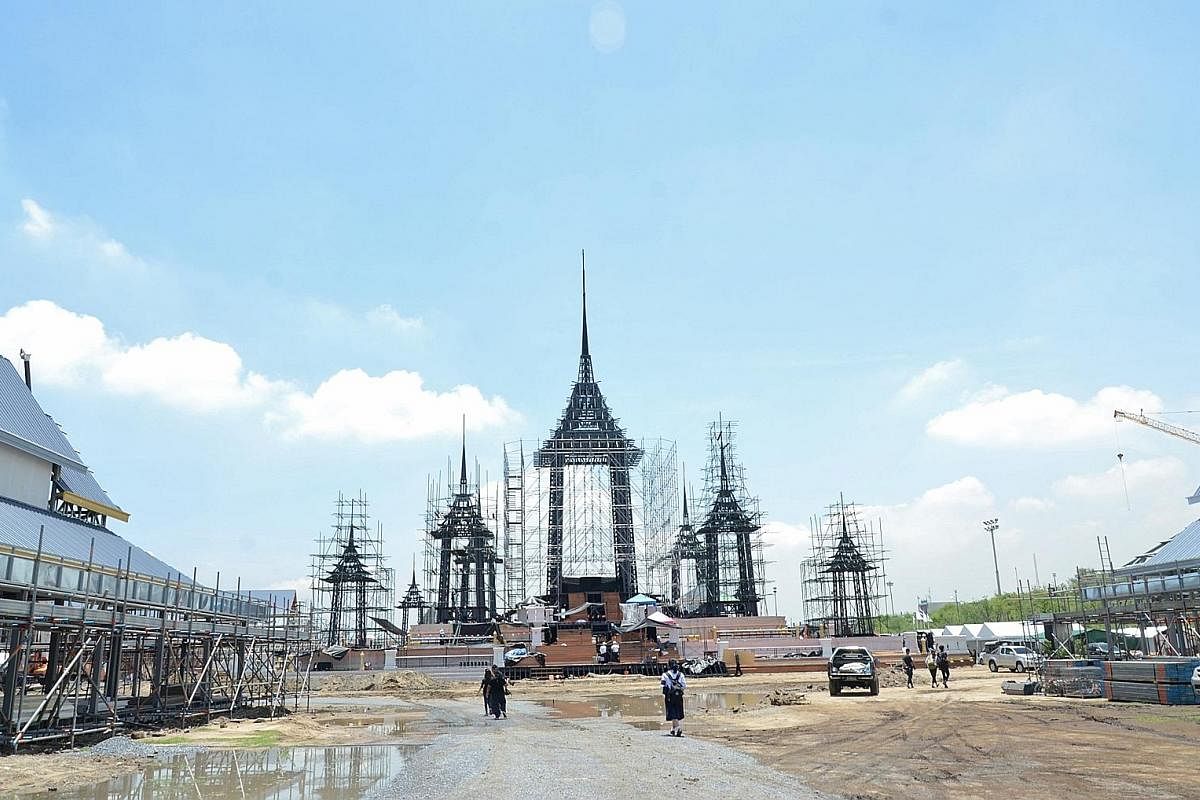
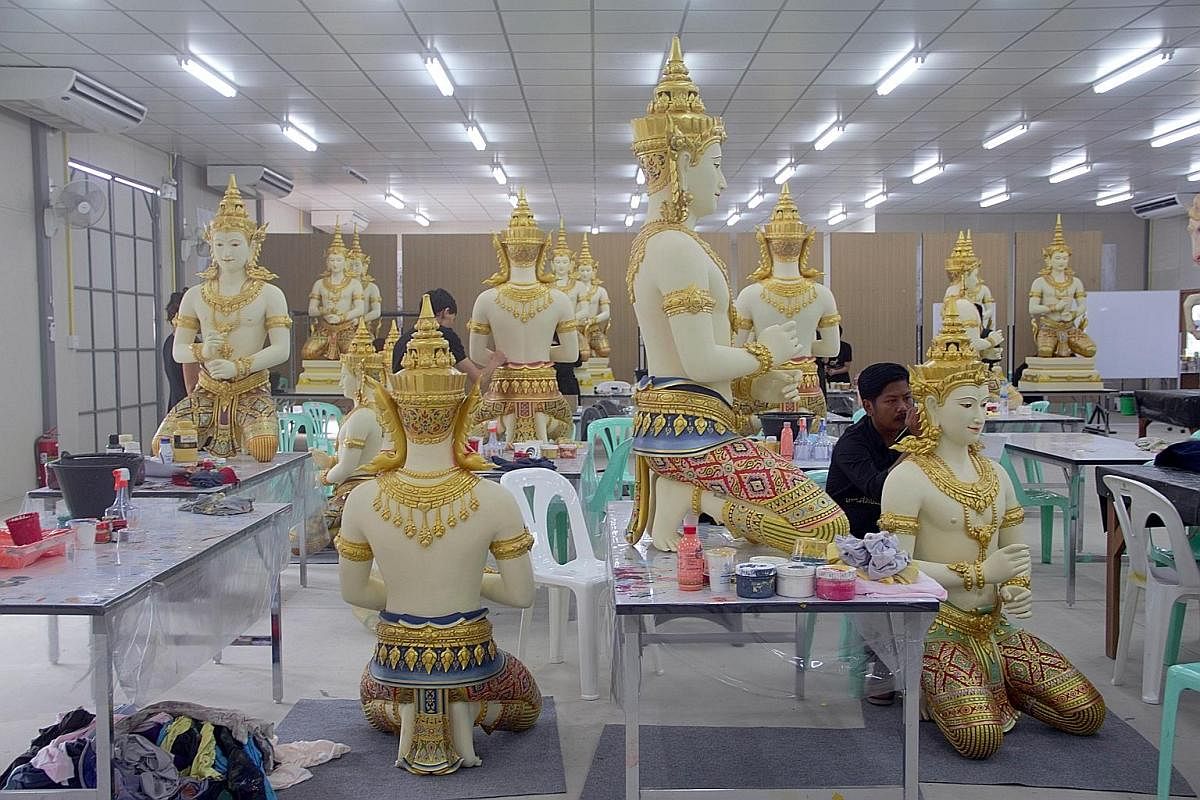
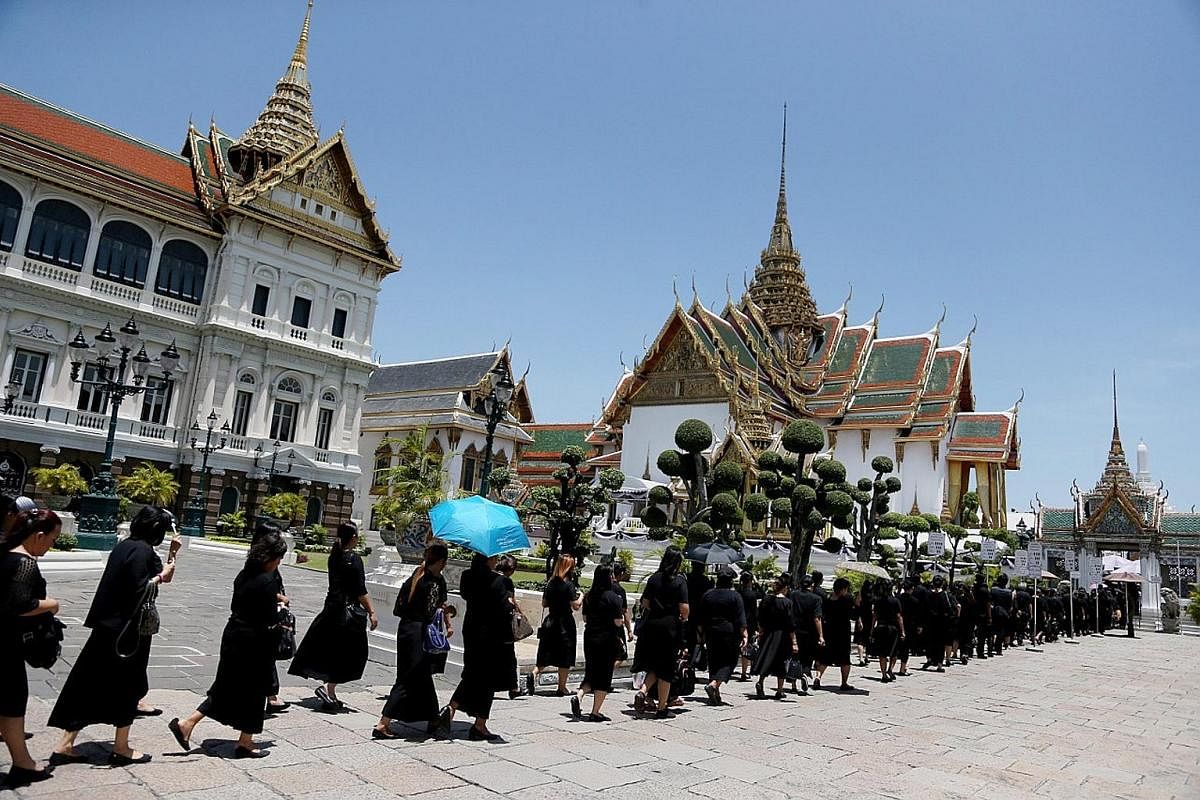

Artist Wichien Saechai bends over as he carefully paints the purple vestment of Phra Narai, one of the 40 god sculptures that will adorn the elaborate complex of the 500 million baht (S$20.4 million) funeral pyre for the last rites of King Bhumibol Adulyadej.
On Oct 26, Thais will bid their final farewell to their most beloved monarch, one who served as a unifying force through the country's many political troubles during his 70-year reign.
Yet craftsmen like Mr Wichien, 36, are already busy at work in one of the large halls just across from the Grand Palace in Sanam Luang, Bangkok, the place known in Thai as "Thung Phra Men" or the royal cremation grounds.
Upon King Bhumibol's death at age 88 on Oct 13 last year after years of poor health, a pall of dark clouds fell over the Land of Smiles. The government cancelled festivals and other events as it announced a one-year mourning period.
Eight months later, Thais clad in black continue to stream to the Grand Palace to pay their last respects to the King, also referred to as Rama IX, who lies in state there.
The cremation will mark the end of the official mourning period, and there is deep apprehension that it could signal the end of an uneasy truce between rival political camps whose tussle has led to deadly street protests and two military coups in the past decade.
-
The cremation grounds
-
• Sanam Luang is also known as Thung Phra Men, or the royal cremation grounds. It measures 119,200 sq m - the size of about 16 football fields.
• A sprawling royal funeral complex covering 78,000 sq m and costing at least 500 million baht (S$20 million) is under construction there.
• The complex will have around 200 sculptures, including those of 40 gods and 20 garuda (mythological bird creatures), and more than 100 animal figurines.
• Three work teams, each with 15 fibreglass workers, 10 sculptors, 10 artists, 60 volunteers.
• The complex will include a pavilion that can accommodate about 7,400 people, including an area for members of the royal family.
• Taking centre stage will be a funeral pyre painted entirely in gold, with a 50m-tall main tower crowned with a seven-tier roof and a spire, and surrounded by eight smaller pavilions.
• The pyre has been designed by well-known names in Thailand: Mr Satawan Homsai, who is architectural director of the Fine Arts Department, engineer Korkiat Thongpud and architect Thirachart Veerayuththanont.
• An incinerator built inside the pyre will be where the late Thai King's body is cremated.
-
 Computer-generated graphic of the late Thai King's funeral complex when it is completed. PHOTO: FINE ARTS DEPARTMENT, THAILAND
Computer-generated graphic of the late Thai King's funeral complex when it is completed. PHOTO: FINE ARTS DEPARTMENT, THAILAND
Shortly after the cremation, the coronation of King Maha Vajiralongkorn Bodindradebayavarangkun, King Bhumibol's successor and only son, is expected to take place. No date has been announced. Observers say the coronation will signal the resumption of political activities, with the general election expected to be called late next year to replace the junta with a new government.
Since February, construction workers have been toiling under the scorching sun to erect the seven-tiered roof and spire of the funeral pyre, surrounded by eight smaller pavilions representing the mountains around Mount Meru, a sacred place in Buddhist cosmology.
It is believed that the divine spirits of kings return to Meru after they die.
Work on the entire complex, which stretches 80m across the northern side of the traditional cremation grounds, is expected to be finished by September. Prime Minister Prayut Chan-o-cha chairs the royal cremation coordination committee, while Deputy Prime Minister Tanasak Patimapagorn heads the committee overseeing the construction of the royal crematorium.
The design of the funeral pyre was based on traditional pyres constructed since the beginning of the Rattanakosin era (1782 to 1932) and will feature elements to reflect the late King's reign.
It will have re-creations of ponds, dams, rice fields, reservoirs and watermills to symbolise the late King's contribution to rural development.
There will also be sculptures depicting magical creatures and deities from Hindu mythology.
Mr Surathkij Peeraphonsil, 54, of the Fine Arts Department under the Ministry of Culture, says there will be a total of 200 sculptures, including 40 gods, 20 garuda and more than 100 animals, that will be positioned across the complex.
There are two special sculptures that will be placed at the centre of the pyre: replicas of the King's dogs Tongdaeng and Cao Cao. Thais know Tongdaeng, which they refer to with the honorific "khun" but not many are familiar with Cao Cao, the King's pet when he was a young boy.
Inside the temporary workshops set up on the ceremonial grounds, there is a palpable sense of calm and solemnnity as artists and craftsmen work on statues, paintings and woodworks.
Respect for the monarchy is deeply ingrained among Thais and during his lifetime, King Bhumibol was treated like a living deity.
"It's an honour to be part of this," says Mr Wichien, who works in the Fine Arts Department under the Ministry of Culture. He is in charge of painting the sculptures of two cows and a god. There are 10 other artists in his team, and they work with volunteers who were selected from about 400 who applied.
Each life-sized sculpture takes two months to complete and 15 days for the finishing touches to be applied.
It is not known how many workers there are for the complex in all, but there are three teams working on the sculptures. Each team has 15 fibreglass workers, 10 sculptors, 10 artists and 60 volunteers helping the artists.
Mr Wichien says words are not enough to express his gratitude for the many good things that the late King had done, a sentiment shared by his teammates.
Ms Naphat Rojanarangsiman, 50, a freelance interior designer, turned down other jobs for five months so that she could volunteer her service.
"I wanted to have a chance to return my gratitude to the late King," she says.
Like many other workers interviewed by The Straits Times, Ms Charong Payungchan, 49, gets teary-eyed whenever she talks about the late King.
"I will miss the King," she says wistfully as she glances at the 50m- tall main cremation tower.
The odd-job worker wakes up at 5am to make an hour-long commute from her home in Taling Chan, 12km from the capital.
Preparations for the King's last rites are not confined to Sanam Luang in Bangkok's old quarters.
There are 101 booths, manned by volunteers, spread all round the capital to make traditional wood flowers that will be distributed to mourners before the royal cremation.
The artificial flowers come in 36 patterns, including roses, orchids, water lilies and daffodils. They are made from locally sourced natural materials like dried banana leaves and trunks, and dried water hyacinths.
According to Thai tradition, wood flowers are placed in front of a deceased person's coffin or urn as a last tribute before cremation.
The royal coffin, which is made of sandalwood, has been completed, while royal carriages to be used in the ceremony are undergoing maintenance.
No budget for the five-day event has been revealed, but it will be the most elaborate cremation ceremony in Thailand's history.
The last one held for a monarch was 67 years ago for King Bhumibol's older brother, Ananda.
Over the years, there have been similar ceremonies for other members of the royal family, but none as grand as this.
Now Thais are on the final stretch of preparations before they bid their final goodbyes to their beloved King Bhumibol.
"I don't want this ceremony to happen," says Mr Surathkij, knowing that the ceremony will mark the end of an era.
Join ST's Telegram channel and get the latest breaking news delivered to you.
A version of this article appeared in the print edition of The Straits Times on June 20, 2017, with the headline Behind the scenes: Labour of love for Thais' most beloved king. Subscribe
